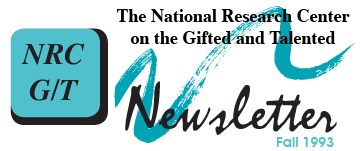
Jonathan A. Plucker
The University of Connecticut
Storrs, CT
Of the many benefits resulting from the end of the Cold War, the increase in intellectual interaction between East and West is perhaps the most significant. Recently, having met psychologists from Eastern Europe and Russia, I became aware of the extensive work being done on creativity, especially in the areas of theory and education. It was with this heightened anticipation that I read Creativity Training by Edward Necka, a member of the Team of Psychology of Creativity at Jagiellonian University in Cracow, Poland, and a recent post-doctoral fellow at Yale University. Necka has been involved with the study of intelligence and has done some promising work on the creativity- intelligence relationship (Necka, 1992).
The purpose of the book is to “aid…psychologists, educators, teachers, social relations specialists, and other persons interested in stimulating people’s creativity” (p. 8), with an emphasis on group training techniques. The following questions can be used as guides when reading this book:
- How do “creative problem-solving” and “creativity training” differ?
- What role does interpersonal interaction play in the creative process?
- What are the creative advantages and disadvantages of working in a group?
- Which mental “abilities” influence creative thinking?
- With respect to creativity training, how flexible should the program be?
The introduction contains a description of the program’s underlying philosophy. A distinction is drawn between creative problem-solving, “techniques which aim at solving a concrete task by means of appropriate manipulations, methods, ‘tricks,’ etc.,” and creativity training, “techniques aiming at developing the creative capabilities of individuals and teams” (p. 7). The techniques (or “tools”) involved in creative problem-solving include brainstorming and synectics, and a group using these techniques is also seen as being a “tool” for problem-solving. In contrast, creativity training is used to increase creative potential, with the individual and group becoming the focus of the activities, rather than being a “tool.” I must admit that this distinction still puzzles me, and I would have liked to have seen a more detailed explanation.
The next section includes two chapters: Interpersonal Skills, based upon the belief that creativity is a group process and seldom occurs outside of a “social context” (p. 9); and Motivations, “the most difficult to train” (p. 10), but still a necessary component of creativity. Chapter Three deals with each of the creative “abilities”: thinking in the abstract, making associations, deductive reasoning, inductive reasoning (analogies), metaphorizing, and transformations. The next chapter deals with obstacles to creativity (both internal and external) and strategies for overcoming them. The organizational schema for the creativity training program is described in reasonable detail in the final chapter, but I would have appreciated this information more thoroughly if it had been provided earlier in the text. Finally, the appendices contain a list of “Emergency” problems to use as part of the training program and a list of “Idea Squelchers” adapted from Davis (1981) and Kaufmann, Fustier, and Drevet (1970).
The sections on motivation and interpersonal skills are excellent, with the latter calling attention to a traditionally underemphasized aspect of creativity. Indeed, this section is the strongest part of the book, full of clever, original activities. The activities for increasing creative abilities in Chapter Three are described in sufficient detail, but they do not seem as promising as those in the previous two chapters. The chapter on overcoming obstacles is appealing because it makes the necessary differentiation between internal and external obstacles. As with the first two chapters, this section should be expanded in future editions. I would also appreciate a smoother English translation (it seems somewhat choppy for an American audience) and the addition of an index.
With the benefit of hindsight, I realize that my anticipation was based upon a desire to see an international perspective on the education of creativity. In this respect, the first paragraph did not disappoint me, as it contains 25 citations from authors in four different countries. Although the suggested activities are based upon the work of the Team of Psychology of Creativity in Cracow, I expected more references within the text, especially from European authors. The select citations are predominantly the work of American authors, since the international work cited in the first paragraph is infrequently mentioned throughout the rest of the book. However, even the references to American authors and their work are quite dated, with less than five after 1982, and no references later than 1987.
With the current ‘intellectual boom’ in creativity theory and research, the omission of current work is the book’s main weakness. The recent work being done with divergent thinking (Runco, 1991), creativity theory (Gardner, 1993; Runco & Albert, 1990; Sternberg, 1988), and economic theory (Runco & Rubenson, 1992; Sternberg & Lubart, 1991) all have a substantial impact upon creativity training. In the final analysis, I expected an international perspective on “creativity training,” but the book delivered an international interpretation of American work on the education of creativity. As a result, most Western readers will find the ideas and suggested activities to be largely familiar. However, I still recommend the book for two reasons: first, the section on interpersonal aspects of creativity; and, second, the book’s historical significance as an indicator of the creativity work currently being done in Poland.
Note: Necka, E. (1992). Creativity Training: A Guidebook for Psychologists, Educators, and Teachers. Kraków, Poland: TAiWPN “UNIVERSITAS” (160 pp.). ISBN 83-7052-092-8 is available directly from the author at the following address: Jagiellonian University, Institute of Psychology, ul. Golebia 13, 31-007 Kraków, Poland.